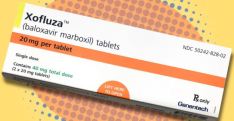Market Authorizations: ARIKAYCE, clonoSEQ Assay, XOFLUZA


ARIKAYCE (amikacin liposome inhalation suspension) oral
inhalation
with LAMIRA nebulizer system
Insmed, Inc
INDICATION: LIMITED POPULATION: Adults, who have limited or no alternative treatment options, for the treatment of Mycobacterium avium complex (MAC) lung disease as part of a combination antibacterial drug regimen in patients who do not achieve negative sputum cultures after a minimum of 6 consecutive months of a multidrug background regimen therapy.
As only limited clinical safety and effectiveness data for ARIKAYCE are currently available, reserve ARIKAYCE for use in adults who have limited or no alternative treatment options. This drug is indicated for use in a limited and specific population of patients.
ADDRESSING UNMET NEED:
- Need to encourage the development of drugs to treat resistant infections
- First approval under Limited Population Pathway for Antibacterial and Antifungal Drugs (LPAD) to spur development of drugs targeting infections that lack effective therapies
MECHANISM OF ACTION: Antibacterial drug
EFFICACY:
- Randomized, controlled clinical trial, n=336 patients with refractory MAC lung disease, ARIKAYCE plus a background regimen or background regimen alone
- Surrogate efficacy endpoint: Culture conversion (3 consecutive monthly negative sputum cultures) by Month 6
- 29% with Arikayce vs. 9% without Arikayce
SAFETY
- Boxed Warning: Increased risk of respiratory conditions including hypersensitivity pneumonitis, bronchospasm, exacerbation of underlying lung disease, hemoptysis
- Common side effects: Dysphonia, cough, ototoxicity, upper airway irritation, musculoskeletal pain, fatigue, diarrhea and nausea.
REGULATORY PATHWAY: NDA
- Fast Track, Breakthrough Therapy, Priority Review, Accelerated Approval, Qualified Infectious Disease Product (QIDP) designations
- Accelerated approval requirements :Randomized, double-blind, placebo-controlled clinical trial to describe clinical benefit in patients with nontuberculous mycobacterial (NTM) lung disease caused by MAC
clonoSEQ Assay
Adaptive Biotechnologies
INDICATION FOR USE: In vitro diagnostic that uses multiplex polymerase chain reaction (PCR) and next-generation sequencing (NGS) to identify and quantify rearranged IgH (VDJ), IgH (DJ), IgK, and IgL receptor gene sequences, as well as translocated BCL1/IgH (J) and BCL2/IgH (J) sequences in DNA extracted from bone marrow from patients with B-Cell acute lymphoblastic leukemia (ALL) or multiple myeloma (MM).
The clonoSEQ Assay measures minimal residual disease (MRD) to monitor changes in burden of disease during and after treatment. The test is indicated for use by qualified healthcare professionals in accordance with professional guidelines for clinical decision-making and in conjunction with other clinicopathological features.
The clonoSEQ Assay is a single-site assay performed at Adaptive Biotechnologies Corporation.
ADDRESSING UNMET NEED:
- Determining whether patient has residual cancer cells remaining after treatment provides information on how well patient responded to therapy and how long remission may last
- Highly sensitive test available to measure minimal residual disease in ALL or multiple myeloma patients can help providers manage their patients’ care
- FDA applying novel regulatory approaches to make sure rapidly evolving NGS tests are accurate and reliable
GENERIC DEVICE TYPE: DNA-based test to measure minimal residual disease in hematological malignancies
- Prescription in vitro diagnostic device that identifies and quantifies specific nucleic acid sequences within human tissues to estimate the percentage of cells that harbor the specific sequence(s). The test is intended to be used as an aid to measure Minimal residual disease to assess the change in burden of disease during Monitoring of treatment. The test is indicated for use by qualified healthcare professionals in accordance with professional guidelines for clinical decision-making, in conjunction with other clinicopathological features.
CLINICAL VALIDITY:
- Retrospective analysis of samples obtained from three previously conducted clinical studies- N=273 patients with ALL, N=323 patients with multiple myeloma (ongoing), N=706 patients with multiple myeloma
- ALL: MRD level correlated with event-free survival
- Multiple myeloma: MRD level correlated with progression-free survival
RISKS & MITIGATIONS:
- Incorrect test results: General controls and special controls
- Incorrect interpretation of test results: General controls and special controls
REGULATORY PATHWAY: De Novo request
- Regulation Number: 21 CFR 866.6100
- Regulatory Class: Class II
- Product Code: QDC
XOFLUZA (baloxavir marboxil) tablets
Shionogi & Co, Genentech USA
INDICATION: Treatment of acute uncomplicated influenza in patients 12 years of age and older who have been symptomatic for no more than 48 hours.
ADDRESSING UNMET NEED:
- First new antiviral flu treatment with novel mechanism of action approved by FDA in nearly 20 year
- Provides an important, additional treatment option
MECHANISM OF ACTION: Prodrug that is converted by hydrolysis to baloxavir that inhibits endonuclease activity of the polymerase acidic protein required for viral gene transcription resulting in inhibition of influenza virus replication
EFFICACY:
- Two randomized controlled clinical trials, n=1,832 patients, Xofluza, vs. placebo, or vs. another antiviral flu treatment (oseltamivir) within 48 hours of experiencing flu symptoms
- Primary endpoint: Time to alleviation of all seven symptoms (cough, sore throat, nasal congestion, headache, feverishness, myalgia, and fatigue)
- Statistically significant shorter time to alleviation of symptoms vs placebo
- No difference in time to alleviation of symptoms vs. oseltamivir
SAFETY:
- Most common adverse reactions: Diarrhea and bronchitis
REGULATORY PATHWAY: NDA
- Priority Review
- Required Pediatric Assessments: Studies in from birth – < 12 months and from 12 months to <12 years of age with acute uncomplicated influenza
- Material Threat Countermeasure (MCM) Priority Review Voucher – Denied
- no form of influenza is listed as a material threat
Image credits: Insmed, Adaptive Biotechnologies, Shionogi/Genentech

